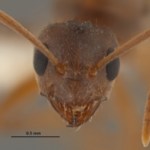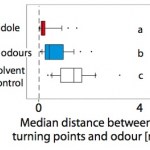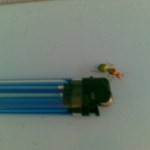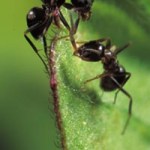ant
Image from www.antforum.nl
Many species of ants are known for being rather clean by disposing of their dead outside of the nest and placing other wastes, like bits of food, in refuse chambers. Dr. Tomer J. Czaczkes (University of Regensburg) was surprised therefore to see "dark patches" build up in plaster nests that housed black garden ants (Lasius niger). Dr. Czaczkes suspected that these dark patches might actually be feces. He tested this hypothesis by adding food coloring to their diet. Perhaps not surprisingly, the dark patches changed to shades of blue and red.
Several theories…
Bone-house wasps protect their young by building walls made of ant carcasses. Image from: Merten Ehmig
A new species of spider wasp that protect their young with walls made of ant carcasses has been discovered in the forests of China. Dr. Michael Staab from the University of Freiburg discovered the new species which he named Deuteragenia ossarium meaning "bone-house wasp" since the wasps reminded him of the ossuaries in Europe with structures decorated from human bones.
Sedlec Ossuary in the Czech Republic. Image from Wikipedia.
Similar to the ossuaries, the bone-house wasps use alive…
Crazy ant image by Joe A. MacGown with the Mississippi Entomological Museum
Tawny (or Raspberry) crazy ants (Nylanderia fulva) are an invasive ant species from South America that have been invading the United States. For some reason, the ants are attracted to electronics and have been responsible for the destruction of numerous electronic devices.
A new study shows that tawny crazy ants rub formic acid over their bodies as a shield against fire ant venom. This conclusion came after researchers observed the ants rubbing themselves with formic acid after a confrontation with fire ants (…
A version of this post was originally published on my Wordpress blog on March 15, 2010. Click the archives image to see the original post.
Most animals, at some point in their day-to-day lives, face the same problem. After they've gone out in search of food, they need to find their way home. But some of the places where these critters live lack any real visual landmarks - like the open ocean or wide expanses of desert. Instead of relying on vision, some animals have developed the ability to use olfactory (scent-related) cues to aid in navigation. Seabirds can detect subtle changes in the…
Human infants have one important job during the first years of life, and that is to learn about the world and their culture from their parents and other caregivers. But what is learning? I've previously written that Hungarian developmental psychologists Gergely and Csibra have defined learning as the acquisition of new, generalizable knowledge that can later be used within a new context. Further, they have posited that evolution has prepared humans to learn generalizable knowledge from their caregivers. They proposed an elegant hypothesis: that a specialized innate pedagogy mechanism - called…
"But wait," you say. "Anteaters aren't pets!" Well, I didn't think so either. But Salvador Dali had a pet anteater. And that's good enough for me.
Figure 1: Salvador Dali taking his pet anteater for a stroll. (Source)
The Giant Anteater, Myrmecophaga tridactyla, only eats ants and termites, making it a myrmecophage. (Hey, Alex Wild, now I get what Myrmecos means!) In 1984, a researcher named Kent Redford was interested in the foraging behaviors of the giant anteater, and the relationship between these anteaters and their prey, colonies of highly social insects. So Redford went to Brazil to…
A normal giant gliding ant (left) and an infested ant (right). The red color of the gaster is not caused by a pigment, but thinning of the exoskeleton combined with the color of the nematode eggs. From Yanoviak et al, 2008.
In one of my favorite episodes of the animated TV show Futurama, the chief protagonist - delivery boy Philip J. Fry - becomes infested with worms after eating a dodgy egg-salad sandwich purchased from the restroom of an interstellar truck stop. Lucky for Fry, the parasites are beneficial - they repair his injuries and greatly enhance his cognitive abilities. ("Of all…
In 1912, Antarctic explorer Captain Lawrence Oates willingly walked to his death so that his failing health would not jeopardise his friends' odds of survival. Stepping from his tent into a raging blizzard, he left his men with the immortal words, "I am just going outside and may be some time." It was a legendary act of heroism but one that is mirrored by far tinier altruists on a regular basis - ants.
Like Captain Oates, workers of the ant species Temnothorax unifasciatus will also walk off to die in solitude, if they're carrying a fungal infection. In fact, Jurgen Heinze and Bartosz…
An Indonesian Zooillogix reader, Harianto Talim, grossly overestimated our entomological abilities and asked us to help him identify an Indonesian ant that he has never seen before. In this blurry series of photos, you can see that the ant is bright orange and green and may or may not smoke cigarettes. It should be noted however that when confronted about the lighter in the ant's pocket by its mother, the queen, the ant claimed it just carries the lighter around to light other ants' cigarettes to look cool.
So nerdy readers, time to prove your mettle by identifying this random blurry ant!…
Hardly a natural history documentary goes by without some mention of leafcutter ants. So overexposed are these critters that I strongly suspect they're holding David Attenborough's relatives to ransom somewhere. But there is good reason for their fame - these charismatic insects are incredibly successful because of their skill as gardeners.
As their name suggests, the 41 species of leafcutter ants slice up leaves and carry them back to their nests in long columns of red and green. They don't eat the leaves - they use them to grow a fungus, and it's this crop that they feed on. It's an old…
In Latin America, there lives a unique spider called Bagheera kiplingi. It's a jumping spider and it shares the group's large, acute eyes and prodigious leaping ability. But it also has a trait that singles it out among all 40,000 species of spider - it's mostly vegetarian.
Virtually all spiders are predators. They may hunt using different methods but they all end up sucking the liquidised innards of their prey. If they consume plants, they do so rarely, even accidentally. Some take the odd sip of nectar to supplement their diet of flesh. Others accidentally swallow pollen while recycling…
A new study in one of our favorite bathroom reading publications, Insectes Sociaux, has revealed that ants are indeed taking over the world and our role as ants' masters will soon be upended. The group looked at a species of Argentinian ant, Linepithema humile, that has hitchhiked to other continents in the last century or so on human vessels (ships, planes, etc.) to form invasive colonies. Previously, scientists had examined the relationship between these different colonies within countries and continents. When Linepithema humile from different colonies come into contact in Argentina, they…
It's been just three weeks since I last wrote about the dark-footed ant-spider Myrmarachne melanotarsa, but this is one species that just keeps getting more and more interesting. To quickly recap, M.melanotarsa is a jumping spider that protects itself from predators (like other jumping spiders) by resembling an ant. Earlier this month, Ximena Nelson and Robert Jackson showed that they bolster this illusion by living in silken apartment complexes and travelling in groups, mimicking not just the bodies of ants but their social lives too.
Now Nelson and Robert are back with another side to the…
In 1979, somewhere in Dartmoor, a butterfly died. That would hardly have been an exceptional event, but this individual was a Large Blue butterfly (Maculinea arion) and it was the last of its kind in the United Kingdom. Over more than a century, the Large Blue's population had been declining and it was finally declared nationally extinct 30 years ago.
Now, it's back. A bold conservation effort managed to work out the factors behind the butterfly's decline, and resurrect this vanished species. The Large Blue's reintroduction has been one of conservation's flagship successes and it was the…
The animal world is full of harmless liars, who mimic species more dangerous than themselves in order to avoid the attention of predators. But none do it quite like the dark-footed ant-spider Myrmarachne melanotarsa.
As its name suggests, this small species of jumping spider, discovered just nine years ago, impersonates ants. In itself, that's nothing special - ants are so aggressive that many predators give them a wide berth and lots of species do well by imitating them. The list includes over 100 spiders but among them, M.melanotarsa's impression is unusually strong. It doesn't just mimic…
We recognise dead people by the absence of signals that indicate life - movement, responsiveness, pulses, brain activity, and so on. The Argentine ant does the same, but its signal is a chemical one. Throughout its life, an ant uses chemicals in its skin to automatically send out a message to its nest-mates, saying "I'm alive. Don't throw me out." When it dies, these "chemicals of life" fade away, and their bodies are evicted.
Social insects like ants and honeybees are fastidious about their colony's tidiness. If any individuals die, they're quickly removed and thrown away in one of the…
Humans aren't the only species that have had to deal with the issue of slavery. Some species of ants also abduct the young of others, forcing them into labouring for their new masters. These slave-making ants, like Protomagnathus americanus conduct violent raids on the nests of other species, killing all the adults and larva-napping the brood.
When these youngsters mature, they take on the odour of their abductors and become the servants of the enslaving queen. They take over the jobs of maintaining the colony and caring for its larvae even though they are from another species; they even…
Ants are among the most successful of living things. Their nests are well-defended fortresses, coordinated through complex communication systems involving touch and chemical signals. These strongholds are stocked with food and secure from the outside world, so they make a tempting prospect for any burglars that manage to break in.
One species of butterfly - the mountain alcon blue (Maculinea rebeli) - is just one such master felon. Somehow, it manipulates the workers into carrying it inside the nest, feeding it and caring for it. The caterpillar does so little for itself that it packs on 98…
Subterranean...blind...predatory...smokin' hot AILF! These are all adjectives that you could use to describe a newly discovered ant from the Amazon rainforest. Dubbed the Martialis heureka or "Ant from Mars" (not kidding), the sightless creature lives inside the soil and presumably hunts prey with massive mandibles. The Ant from Mars also represents a new subfamily of ant, a discovery that hasn't happened since 1923 (Note: see comments for various competing view points).
Take me to your watermelon.
After evaluating the DNA of the ant, researchers have concluded that this ant is on the bottom…






